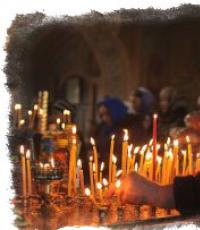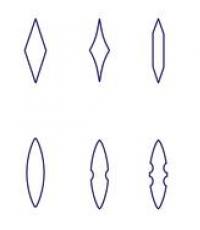Lytkina Alena Presentation on the topic “Stonehenge”. Stonehenge (English: Stonehenge, lit. “stone henge”) is a megalithic structure in Wiltshire, England - presentation. Presentation on the topic "Stonehenge" Presentation on the legend of the origin of Stonehenge on
Plan of Stonehenge 1 = The Altar Stone, a six ton monolith of green micaceous sandstone from Wales 2 = barrow without a burial 3 = "barrows" (without burials) 4 = the fallen Slaughter Stone, 4.9 meters long 5 = the Heel Stone 6 = two of originally four Station Stones 7 = ditch 8 = inner bank 9 = outer bank 10 = The Avenue, a parallel pair of ditches and banks leading 3 km to the River Avon 11 = ring of 30 pits called the Y Holes 12 = ring of 29 pits called the Z Holes 13 = circle of 56 pits, known as the Aubrey holes 14 = smaller southern entrance
Druids Temple The theory that the Druids were responsible may be the most popular one; however, the Celtic society that spawned the Druid priesthood came into being only after the year 300 BC. Additionally, the Druids are unlikely to have used the site for sacrifices, since they performed the majority of their rituals in the woods or mountains, areas better suited for "earth rituals" than an open field.
Stonehenge as a graveyard There is a theory that Stonehenge was used for burials. Indeed, burials were found on the monuments territory, but they were made much later after Stonehenge had been built. According to news reports, a professor of archeology from the University of Sheffield, Mike Parker Pearson, who manages the Stonehenge Riverside Archaeological Project noted that in his opinion Stonehenge from the very beginning of its existence and to flourish in the third millennium BC was considered by inhabitants of England as an area for the burial of the dead.
Conclusion It's difficult to judge which of the theories is correct, but from what I have read I can do the conclusion that Stonehenge is the most mysterious symbol of Britain, which went through the whole history with this country and gives it special charm of mystery and unexploredness.
The work can be used for lessons and reports on the subject "English"
The section contains ready-made presentations on Foreign languages for children, schoolchildren, students and adults. Also, presentations on the English language will be useful for teachers and lecturers to demonstrate sights, monuments, cities and countries, as well as grammar tables from textbooks. Here, you can download presentations on English for grades 1,2,3,4,5,6,7,8,9,10,11. All presentations in English can be downloaded absolutely and without registration.
Slide 1
 Slide 2
Slide 2
 Slide 3
Slide 3
 Slide 4
Slide 4
 Slide 5
Slide 5
 Slide 6
Slide 6
 Slide 7
Slide 7
 Slide 8
Slide 8
 Slide 9
Slide 9
The presentation on the topic "Stonehenge - stonehenge" can be downloaded absolutely free on our website. Subject of the project: English language. Colorful slides and illustrations will help you engage your classmates or audience. To view the content, use the player, or if you want to download the report, click on the corresponding text under the player. The presentation contains 9 slide(s).
Presentation slides

Slide 1

Slide 2
Location of Stonehenge
Stonehenge is a prehistoric monument located in the English county of Wiltshire about 3.2 kilometers west of Amesbury and 13 kilometers north of Salisbury.

Slide 3
Plan of Stonehenge
1 = The Altar Stone, a six ton monolith of green micaceous sandstone from Wales 2 = barrow without a burial 3 = "barrows" (without burials) 4 = the fallen Slaughter Stone, 4.9 meters long 5 = the Heel Stone 6 = two of originally four Station Stones 7 = ditch 8 = inner bank 9 = outer bank 10 = The Avenue, a parallel pair of ditches and banks leading 3 km to the River Avon 11 = ring of 30 pits called the Y Holes 12 = ring of 29 pits called the Z Holes 13 = circle of 56 pits, known as the Aubrey holes 14 = smaller southern entrance

Slide 4

Slide 5
Astronomy and Stonehenge
The prehistoric monument of Stonehenge has long been studied for its possible connections with ancient astronomy. Archaeoastronomers have claimed that Stonehenge represents an "ancient observatory," although the extent of its use for that purpose is in dispute. Many also believe that the site may have had astrological/spiritual significance attached to it as well. The discovery of evidence for a neighbor to the Heel Stone has challenged the interpretation of it as a midsummer sunrise marker. The second stone may have instead been one side of a "solar corridor" used to frame the sunrise.

Slide 6
The theory that the Druids were responsible may be the most popular one; however, the Celtic society that spawned the Druid priesthood came into being only after the year 300 BC. Additionally, the Druids are unlikely to have used the site for sacrifices, since they performed the majority of their rituals in the woods or mountains, areas better suited for "earth rituals" than an open field.
Slide 7
Stonehenge as a graveyard
There is a theory that Stonehenge was used for burials. Indeed, burials were found on the monuments territory, but they were made much later after Stonehenge had been built. According to news reports, a professor of archeology from the University of Sheffield, Mike Parker Pearson, who manages the Stonehenge Riverside Archaeological Project noted that in his opinion Stonehenge from the very beginning of its existence and to flourish in the third millennium BC was considered by inhabitants of England as an area for the burial of the dead.

Slide 8
Many early historians were influenced by supernatural folktales in their explanations. Some legends held that Merlin had a giant build the structure for him or that he had magically transported it from Mount Killarausin Ireland, while others held the Devil responsible. Henry of Huntingdon was the first to write of the monument around 1130 soon followed by Geoffrey of Monmouth who was the first to record fanciful associations with Merlin which led the monument to be incorporated into the wider cycle of European medieval romance. According to Geoffrey's Historia Regum Britanniae, using his magic Merlin took the circle from its original place in Ireland at the behest of Aurelius Ambrosius to serve as an appropriate burial place for Britain's dead princes.

1 slide

2 slide
Location of Stonehenge Stonehenge is a prehistoric monument located in the English county of Wiltshire about 3.2 kilometers west of Amesbury and 13 kilometers north of Salisbury.

3 slide
Plan of Stonehenge 1 = The Altar Stone, a six ton monolith of green micaceous sandstone from Wales 2 = barrow without a burial 3 = "barrows" (without burials) 4 = the fallen Slaughter Stone, 4.9 meters long 5 = the Heel Stone 6 = two of originally four Station Stones 7 = ditch 8 = inner bank 9 = outer bank 10 = The Avenue, a parallel pair of ditches and banks leading 3 km to the River Avon 11 = ring of 30 pits called the Y Holes 12 = ring of 29 pits called the Z Holes 13 = circle of 56 pits, known as the Aubrey holes 14 = smaller southern entrance

4 slide

5 slide
Astronomy and Stonehenge The prehistoric monument of Stonehenge has long been studied for its possible connections with ancient astronomy. Archaeoastronomers have claimed that Stonehenge represents an "ancient observatory," although the extent of its use for that purpose is in dispute. Many also believe that the site may have had astrological/spiritual significance attached to it as well. The discovery of evidence for a neighbor to the Heel Stone has challenged the interpretation of it as a midsummer sunrise marker. The second stone may have instead been one side of a "solar corridor" used to frame the sunrise.

6 slide
Druids Temple The theory that the Druids were responsible may be the most popular one; however, the Celtic society that spawned the Druid priesthood came into being only after the year 300 BC. Additionally, the Druids are unlikely to have used the site for sacrifices, since they performed the majority of their rituals in the woods or mountains, areas better suited for "earth rituals" than an open field.
7 slide
Stonehenge as a graveyard There is a theory that Stonehenge was used for burials. Indeed, burials were found on the monuments territory, but they were made much later after Stonehenge had been built. According to news reports, a professor of archeology from the University of Sheffield, Mike Parker Pearson, who manages the Stonehenge Riverside Archaeological Project noted that in his opinion Stonehenge from the very beginning of its existence and to flourish in the third millennium BC was considered by inhabitants of England as an area for the burial of the dead.

8 slide
Legends Many early historians were influenced by supernatural folktales in their explanations. Some legends held that Merlin had a giant build the structure for him or that he had magically transported it from Mount Killarausin Ireland, while others held the Devil responsible. Henry of Huntingdon was the first to write of the monument around 1130 soon followed by Geoffrey of Monmouth who was the first to record fanciful associations with Merlin which led the monument to be incorporated into the wider cycle of European medieval romance. According to Geoffrey's Historia Regum Britanniae, using his magic Merlin took the circle from its original place in Ireland at the behest of Aurelius Ambrosius to serve as an appropriate burial place for Britain's dead princes.

Slide 9
Conclusion It's difficult to judge which of the theories is correct, but from what I have read I can do the conclusion that Stonehenge is the most mysterious symbol of Britain, which went through the whole history with this country and gives it special charm of mystery and unexploredness.
Characteristics It is located in
Wiltshire, England.
It is a monument built
in the Neolithic and
Bronze Age.
Stonehenge is a large
circle of
standing stones.
How was it built?
FIRST STAGE
The first Stonehenge was a largeearthwork probably built around 3100 BC.
They formed a circle. Archaeologists found
cremated human bones, but they were
probably from part of a religious
ceremony
After that, the monument didn’t change
until 1000 years later.
SECOND STAGE
It started around 2150 BC. About 82bluestones from the Preseli mountains in
south-west Wales were brought to the site.
This journey was nearly 240 miles.
Once there, the stones were set up in the
center to make an incomplete double
circle.
THIRD STAGE
It started in 2000 BC. The Sarsen stonesthat they used were probably brought from
the Marlborough Downs area near
Avebury, about 25 miles north of
Stonehenge.
These were placed in an outer circle.
Inside the circle, there were also five
trilithons, that still remain today.
FINAL STAGE
After 1500 BC the bluestones were movedinto the horseshoe and circle that we see
today.
Most of the bluestones have been
removed or broken.
Possible theories about Stonehenge
Stonehenge was an astronomicalobservatory
They could predict eclipses, lunar phases and
seasons. Nevertheless, it was possible that it
was not the original function because it took
more than 1000 years to finish it.
Stonehenge was a cemetery
Scientists found human bones buried there.
Diapositiva 9
Stonehenge was a religious templePeople went there because the Druids
could give them magic power and cure
their illnesses.
Incredible theories
Stonehenge wasbuilt by Apollo's
followers who
lived in the north
of Europe and
were
documented in
Greek mythology.
Stonehenge
was a place
where UFOs
landed.
Diapositiva 11
Stonehenge wascreated in the first
years of the XX
century to attract
tourists.
Stonehenge was
built by the wizard
Merlin. He made it
himself by raising
the stones with his
magical power.
Vocabulary:
Bluestone-piedras del Stonehengetraídas de fuera
Bronze age -edad de bronce
(to) cremate -incinerar, cremar
Druid-Druida
Horseshoe-herradura
Neolithic-neolitico
Sarsen stone -piedra arenisca
Standing stone - megalito vertical
Trilithon -estructura de dos piedras
verticales (columnas) and una horizontal
apoyada en la verticales.
UFO -OVNI (objeto volador no identificado)
Wizard Merlin -El mago Merlin
Slide 1
Stonehenge
Stonehenge, one of the great Seven Wonders of the World
Slide 2

Great Britain
Slide 3

Back when Stonehenge was built people had no way of telling the time. Perhaps the Druids wished to keep records of events. Stonehenge is said by some to be one widespread sundial, a clock used in ancient times. When the sun rises it casts a shadow though an opening in the one side of Stonehenge, the day passes and the shadow move across the middle showing the druids the time of day.
Slide 4

It is located about 3 km west of Amesbury and 13 km north of Salisbury
The Stonehendge is in a county Wiltshire, in vicinities of Salisbury. The nearest motorways – A303 and A344/360. The nearest railway stations – Salisbury and Grejtli (approximately in 16 kilometers). From London it is necessary to go from Waterloo station by train to Salisbury (1.5 hours). Further at station in Salisbury it is possible to buy the ticket for the bus in a Stonehendge.
Slide 5

Gathering place for religions
Gathering place for religions
So taking into account that Stonehenge could predict eclipses another thought is that it was just used for predicting the full moon. The full moon meant new life, so perhaps they used Stonehenge for ceremonies to worship new life.
Slide 6

Nobody knows its precise purpose.
Slide 7

They say that it is connected with the sun and the moon.
The moon, it has been a sight for all over time. Back long ago little was none of the reasons for an eclipses, it was thought to be a sing from the gods. In a society which worshiped gods for all the mysteries of the world, the eclipse must have been very special. The builders of Stonehenge must have been marveled at the sight of this holy event, which happened every four years. Most likely the great Stonehenge was built to be a prediction device for the eclipse. Many people have studied Stonehenge and many have found that the stones are mathematically placed to show when and eclipse might occur. "In favor of this solution - that the Aubrey holes were used as a computer are these facts: the number 56 is the smallest number that measures the swing of the moon with an over-all accuracy of better than 3 days, and lunar cycles provide the only method of long-range eclipse prediction related to the seasons of the year."




